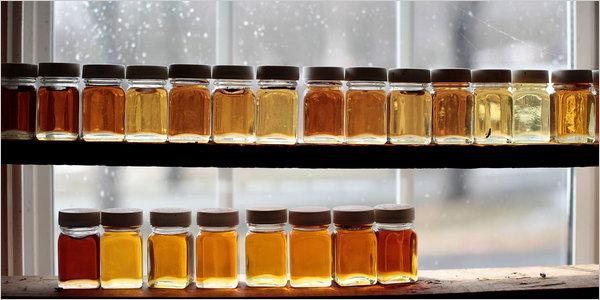- Tags:
- Working Forests

What grade syrup is your favorite?
Maple syrup—the making and the marketing of it—is at once as simple as can be and surprisingly complicated.
Making the naturally sweet treat is as easy as drilling a hole in a sugar maple tree, collecting the sap that runs out of it, and then boiling the sap down until it’s as sweet and thick as you like it. Just add pancakes. Or waffles. Or ice cream. Or for the truly decadent, maybe just a straw.
But there are at least three things that conspire to complicate such a simple recipe. First, anytime a man has the chance to invent all sorts of gadgets that he simply must have in order to properly accomplish a task, history has shown that he will do exactly that. I learned to make maple syrup on family land in the upper elevations of the mountains of West Virginia (yes, there are sugar maples that far south—for now, anyway). We used a bit and brace to drill a hole and hand-carved wooden spiles stuck in the hole to funnel the sap into an odd assortment of water buckets and kitchen pots and pans. We boiled it in a kettle over an open fire, and it was delicious.
Today, I’m just a small-scale hobbyist but instead of a kettle I have a purpose-built raised-flue evaporator with a separate syrup pan, sitting on a firebox equipped with a blower and fresh sap feeding automatically as the roaring wood fire boils it down. Leading up to the start of the season, I pore over catalogs of sugarmaking supplies showing off the latest greatest gewgaws that are guaranteed to increase production, promote tree health, or save labor while making maple syrup. If I bought all the tools and gadgets I thought I needed and still wanted to sell my syrup at a profit I’d have to charge about $300 a gallon, which is about six times the going rate. It’s a perfect way to make a small fortune if you’re starting out with a large one.
The second complicating factor is that maple syrup is--as I hope you noticed this morning at breakfast--food. And thus there are not only certain expectations and minimum standards for cleanliness and lack of contamination, but the market also prefers consistent quality. That means there are specific rules to follow about the kind of equipment one uses, bottling temperature, viscosity, etc. The reputation of real maple syrup rests in every sugarmaker’s hands.
The third complication is what to call the stuff. Its maple syrup, sure, but one fellow’s top grade stuff should probably be the same as the next fellow’s top grade stuff so the consumer knows what they’re getting when they dig deep to pay for the real deal. For a while now, we’ve agreed to describe syrup by color as Grade A Light Amber, Grade A Medium Amber, Grade A Dark Amber, and Grade B. Grade B often comes with the qualifier that is of no lower quality than Grade A, but rather just darker and more mapley in flavor. Some folks will tell you that they like taste of Grade B better; some sugarmakers will tell you it’s the best, too, but there’s a chance that might be because their shelves are empty of Grade A. After all, the best stuff of all is the stuff you’ve got.
But just as I was never able to convince my parents that the ‘B’ on my report card was just as good as an ‘A’, so the industry has decided to address the perception that somehow Grade B is the underachiever of the syrup family. For some time now the International Maple Syrup Association (yes, there is one) has been considering new, simpler names for the different grades of maple syrup. After all, if the most excellent beer can be light or dark, why shouldn’t all shades of maple be equally valued?
And so you will begin to begin to see Grade A: Golden, Delicate Taste; Grade A: Amber, Rich Taste; Grade A: Dark, Robust Taste; and Grade A: Very Dark, Strong Taste. But no Grade B. And it should go without saying that the best of these are New Hampshire-made, though there are rumors that a few people in Maine and Vermont occasionally get around to making a gallon or two.
My advice? Better get the last of the Grade B while you still can. ‘Cause I hear they aren’t making it anymore, and it’s so good it might even be worth $300 a gallon.
To learn more about sugarmaking, visit one of New Hampshire’s many sugarhouses this season. The Forest Society’s Rocks Estate hosts the NH Maple Experience, which you can find out about by visiting www.therocks.org.
Jack Savage is the editor of Forest Notes: New Hampshire’s Conservation Magazine published by the Society for the Protection of New Hampshire Forests. He can be reached at jsavage@forestsociety.org.
